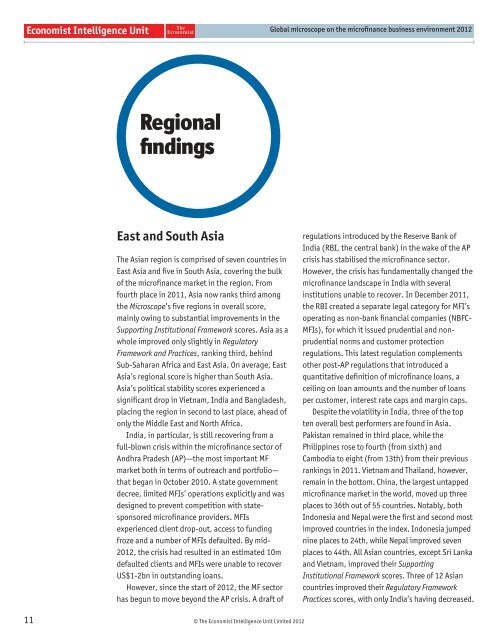Global microscope on the microfinance business environment 2012
Global microscope on the microfinance business environment 2012
Global microscope on the microfinance business environment 2012
Create successful ePaper yourself
Turn your PDF publications into a flip-book with our unique Google optimized e-Paper software.
11<br />
Regi<strong>on</strong>al<br />
fi ndings<br />
East and South Asia<br />
The Asian regi<strong>on</strong> is comprised of seven countries in<br />
East Asia and fi ve in South Asia, covering <strong>the</strong> bulk<br />
of <strong>the</strong> microfi nance market in <strong>the</strong> regi<strong>on</strong>. From<br />
fourth place in 2011, Asia now ranks third am<strong>on</strong>g<br />
<strong>the</strong> Microscope’s fi ve regi<strong>on</strong>s in overall score,<br />
mainly owing to substantial improvements in <strong>the</strong><br />
Supporting Instituti<strong>on</strong>al Framework scores. Asia as a<br />
whole improved <strong>on</strong>ly slightly in Regulatory<br />
Framework and Practices, ranking third, behind<br />
Sub-Saharan Africa and East Asia. On average, East<br />
Asia’s regi<strong>on</strong>al score is higher than South Asia.<br />
Asia’s political stability scores experienced a<br />
signifi cant drop in Vietnam, India and Bangladesh,<br />
placing <strong>the</strong> regi<strong>on</strong> in sec<strong>on</strong>d to last place, ahead of<br />
<strong>on</strong>ly <strong>the</strong> Middle East and North Africa.<br />
India, in particular, is still recovering from a<br />
full-blown crisis within <strong>the</strong> microfi nance sector of<br />
Andhra Pradesh (AP)—<strong>the</strong> most important MF<br />
market both in terms of outreach and portfolio—<br />
that began in October 2010. A state government<br />
decree, limited MFIs’ operati<strong>on</strong>s explicitly and was<br />
designed to prevent competiti<strong>on</strong> with statesp<strong>on</strong>sored<br />
microfi nance providers. MFIs<br />
experienced client drop-out, access to funding<br />
froze and a number of MFIs defaulted. By mid-<br />
<strong>2012</strong>, <strong>the</strong> crisis had resulted in an estimated 10m<br />
defaulted clients and MFIs were unable to recover<br />
US$1-2bn in outstanding loans.<br />
However, since <strong>the</strong> start of <strong>2012</strong>, <strong>the</strong> MF sector<br />
has begun to move bey<strong>on</strong>d <strong>the</strong> AP crisis. A draft of<br />
© The Ec<strong>on</strong>omist Intelligence Unit Limited <strong>2012</strong><br />
<str<strong>on</strong>g>Global</str<strong>on</strong>g> <str<strong>on</strong>g>microscope</str<strong>on</strong>g> <strong>on</strong> <strong>the</strong> microfi nance <strong>business</strong> envir<strong>on</strong>ment <strong>2012</strong><br />
regulati<strong>on</strong>s introduced by <strong>the</strong> Reserve Bank of<br />
India (RBI, <strong>the</strong> central bank) in <strong>the</strong> wake of <strong>the</strong> AP<br />
crisis has stabilised <strong>the</strong> microfi nance sector.<br />
However, <strong>the</strong> crisis has fundamentally changed <strong>the</strong><br />
microfi nance landscape in India with several<br />
instituti<strong>on</strong>s unable to recover. In December 2011,<br />
<strong>the</strong> RBI created a separate legal category for MFI’s<br />
operating as n<strong>on</strong>-bank fi nancial companies (NBFC-<br />
MFIs), for which it issued prudential and n<strong>on</strong>prudential<br />
norms and customer protecti<strong>on</strong><br />
regulati<strong>on</strong>s. This latest regulati<strong>on</strong> complements<br />
o<strong>the</strong>r post-AP regulati<strong>on</strong>s that introduced a<br />
quantitative defi niti<strong>on</strong> of microfi nance loans, a<br />
ceiling <strong>on</strong> loan amounts and <strong>the</strong> number of loans<br />
per customer, interest rate caps and margin caps.<br />
Despite <strong>the</strong> volatility in India, three of <strong>the</strong> top<br />
ten overall best performers are found in Asia.<br />
Pakistan remained in third place, while <strong>the</strong><br />
Philippines rose to fourth (from sixth) and<br />
Cambodia to eight (from 13th) from <strong>the</strong>ir previous<br />
rankings in 2011. Vietnam and Thailand, however,<br />
remain in <strong>the</strong> bottom. China, <strong>the</strong> largest untapped<br />
microfi nance market in <strong>the</strong> world, moved up three<br />
places to 36th out of 55 countries. Notably, both<br />
Ind<strong>on</strong>esia and Nepal were <strong>the</strong> fi rst and sec<strong>on</strong>d most<br />
improved countries in <strong>the</strong> index. Ind<strong>on</strong>esia jumped<br />
nine places to 24th, while Nepal improved seven<br />
places to 44th. All Asian countries, except Sri Lanka<br />
and Vietnam, improved <strong>the</strong>ir Supporting<br />
Instituti<strong>on</strong>al Framework scores. Three of 12 Asian<br />
countries improved <strong>the</strong>ir Regulatory Framework<br />
Practices scores, with <strong>on</strong>ly India’s having decreased.















![Joint Report on Social Protection and Social Inclusion [2005]](https://img.yumpu.com/19580638/1/190x132/joint-report-on-social-protection-and-social-inclusion-2005.jpg?quality=85)
